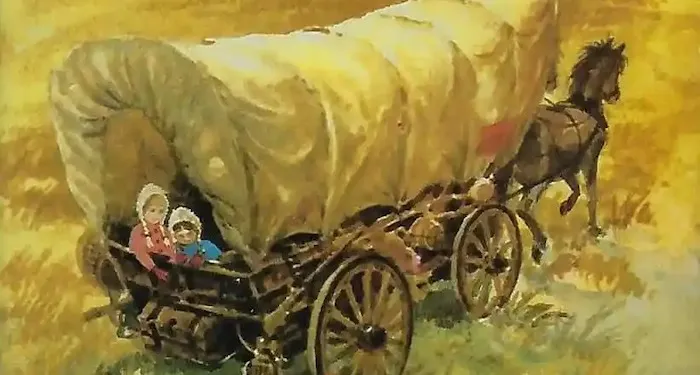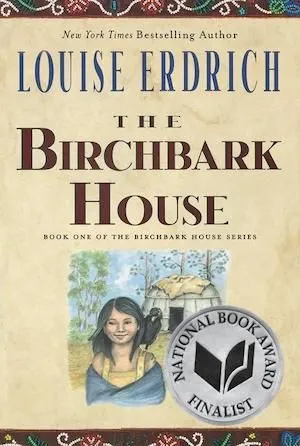
Deconstructing LITTLE HOUSE ON THE PRAIRIE
Little House on the Prairie by Laura Ingalls Wilder is one of those books that shows up on many, many children’s must-read book lists and children’s reading challenges, and at the same time, its place on these lists is also challenged because of its racist content. I see homeschoolers debating this all the time on Instagram: should they read it, should they skip over parts, should they talk about the larger context and implications with their kids? There’s a lot to consider.
I’d never read Laura Ingalls Wilder, so I didn’t understand the nostalgia for Little House when people would talk about it. What I did note is that many times in response to various book lists, it was recommended to either switch out Little House for The Birchbark House, by Louise Erdrich, or read the books concurrently. I’d never read that book either, so I decided to read both, to deconstruct — maybe decolonize is the better word? — Wilder’s novel and come up with an approach that might be useful for learning with my son in the future.
Reading the Books

Many children’s classics have problematic language or themes: as with any piece of literature, the author is writing from a certain point in time and their own thought processes. (I’m not excusing it, just observing). Little House on the Prairie is actually the third book in the Little House series, but the second one to focus on Laura’s childhood (the second book in the series looks at her future husband’s childhood). In Little House, Pa decides to move the family from Wisconsin to Indian Territory, in Kansas — land that was still under Osage ownership.
In the book, there are multiple scenes where Indigenous characters are portrayed negatively and some pretty horrible things are said by both Ma and Pa, and even Laura. Later on, in another book, there are anti-Black comments and minstrel scenes as well.

The Birchbark House, on the other hand, is the first book in the Birchbark series, following a little girl named Omakayas and her Ojibwe tribe, near today’s Lake Superior. In the first book, we meet her family and community, see various cultural practices, and Omakayas learns more about her personal history and why she stayed healthy during the smallpox outbreak, helping to keep her family safe. It’s a book very much rooted in the natural world, working with and living alongside nature and respecting it, which felt markedly different than Little House.
Whereas Little House feels very much centered on independent exploration and expansion (though there are moments of community), Birchbark House is much more centered on the larger community, in my reading of the books. Omakayas feels like a stronger character to me, whereas Laura seemed very…bland. Both have strong family connections through each book, so I can see why they’ve endured for so many children.
Talking With Kids
As I was reading the books, I kept thinking about how I would approach this with my son, who will be 6 soon. I’m a big believer that there are age-appropriate ways to talk about hard things with kids — kids are aware of a lot more than people give them credit for. (With the caveat that each child is different. You know your child best and at what ages are most appropriate to have certain conversations, and at what levels.)
Reading Little House, in the second half of the book, Laura is talking to Pa about how the government makes the Indigenous people move. The conversation goes as such:
“Yes,” Pa said. “When white settlers come into a country, the Indians [sic] have to move on. The government is going to move these Indians farther west, any time now. That’s why we’re here, Laura. White people are going to settle all this country, and we get the best land because we get here first and take our pick. Now do you understand?”
“Yes, Pa,” Laura said. “But Pa, I thought this was Indian territory. Won’t it make the Indians mad to have to – “
“No more questions, Laura,” Pa said, firmly. “Go to sleep.”
So close, Laura. You almost got it. As much as I cringed while reading that, I also realized that this passage would be a great opportunity to talk with my son about history, and true history, if we read this book. Comparing the two books and discussing ownership of the land are things that can be brought up, especially talking about Omakayas and her family, and their lived experiences and rights to the land and their home, and how this differs from what Pa thinks. Even the most obvious line — they weren’t there first, but who was? — can start a conversation.
Roxane Gay has written about how reading the Little House books has impacted her life, and how she remembers them 40+ years later — but she also adds that “The books just have to be taught in context, and the proper context, not revisionist context.” Wilder biographer Pamela Smith Hill agrees, emphasizing that we need to discuss these issues honestly with children, so that they can understand what really happened — cutting those scenes out of the book isn’t the answer.
On an even more basic level, we could talk about making assumptions about people we don’t know, and whether that’s a good thing to do. We can talk about diversity and how people look different from each other, why that is, and what it means — and why it’s not a bad thing, as Ingalls makes it seem to be in the book.
From a craft perspective, I thought Erdrich’s book was better. The writing was more descriptive, the characters better developed, and the story felt like it had more depth. I’m not really invested in the Ingalls family’s travels, to be honest, but my interest is piqued with Omakayas and her family. The way Erdrich handled grief and intergenerational friendship was so well-done, and could spark conversations of a whole different type with my son.
Moving Forward With Classics
Classics have endured for a variety of reasons. Many people love these books, even when aware of issues with content. They love them for the memories they evoke of childhood or their experience of reading them. Many things can exist at the same time, but it’s up to us to seize that opportunity to start those meaningful conversations, if that’s important to us. We can appreciate the books and their role in our childhoods, and also see that they may not really hold up as well today and explore the reasons why.
Of course we want to share our own childhood favorites with our children. We can re-read potentially problematic favorites and figure out ways to talk about the issues with our children, and place them in true, accurate historical contexts as well as present-day contexts. If they happen to pair well with a current book with a diverse perspective that the original ignores or discounts, reading them both concurrently can make for a deeper, more nuanced study of both books and discussions of important events and issues.
Do any of your favorite children’s books fit this example? What could you pair it with? If you’re looking for even more discussion of classic children’s literature, check out this post on why Harriet is still spying, and this post on children’s books to boost cultural literacy.









